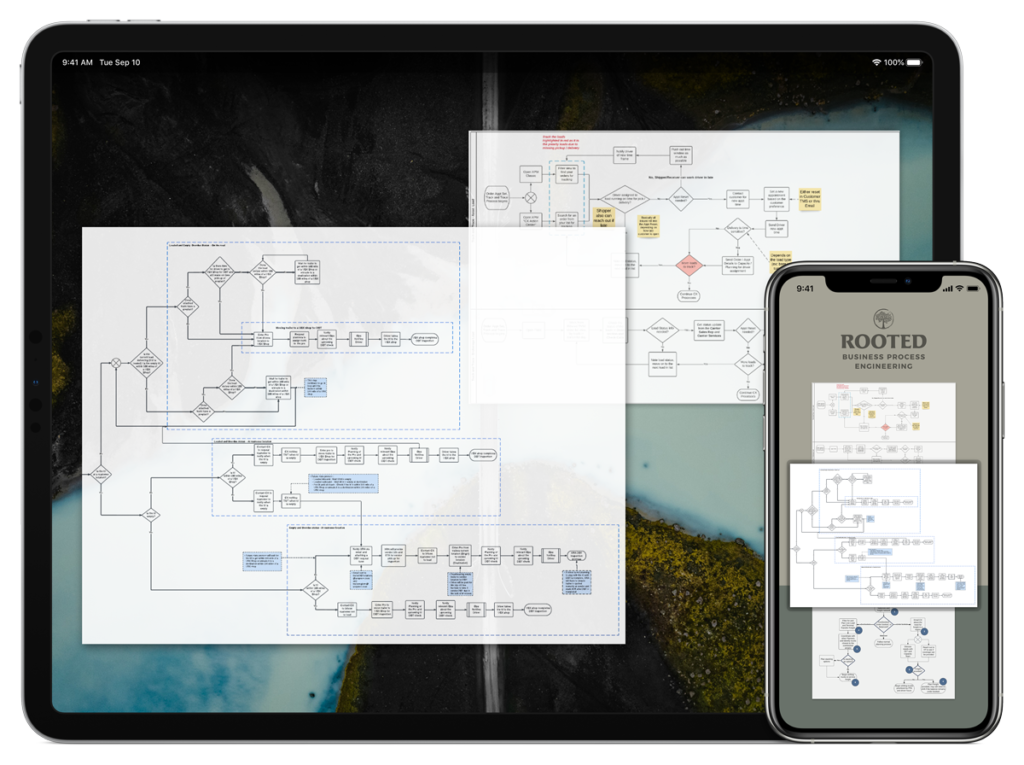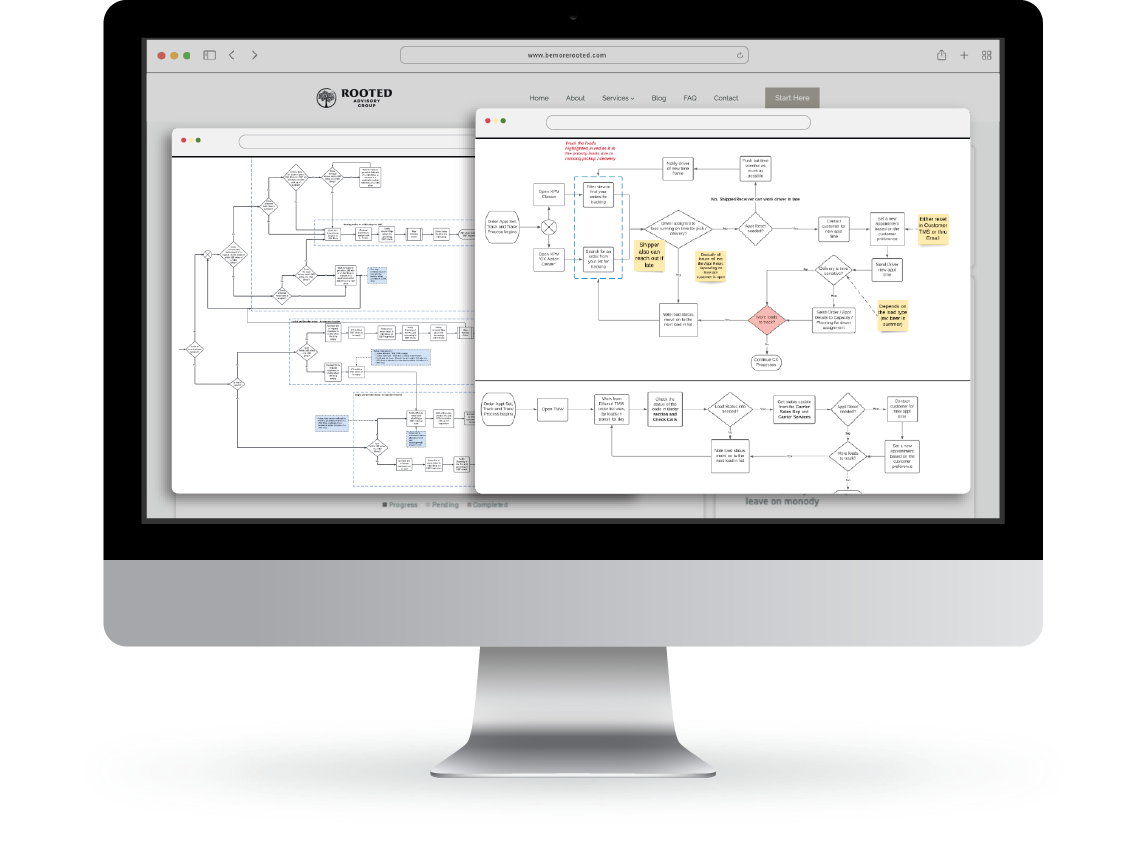About BP{r}E
What is Business Process Engineering?
Business Process Engineering (and reengineering) is a holistic approach to improving an organization’s performance by optimizing and managing its business processes.
BPE is the methodical redesign and optimization of an organization’s workflows, structures, and systems to enhance efficiency, productivity, and alignment with strategic objectives.
It involves identifying and eliminating inefficiencies, streamlining processes, and fostering continuous improvement within the business. An intentional Process Engineering program will empower your business to efficiently pursue strategic goals and objectives in a more meaningful and intentional way.
If you can’t describe what you are doing as a process, you don’t know what you are doing.
W. Edwards Deming
About BP{r}E
What is included in a Rooted BPE program?
Rooted provides expertise at all stages of the business process lifecycle, from current-state documentation through a completely reengineered and reimagined architecture of business workflows.

Business Process Model & Workflows
The first step is to create a comprehensive current-state process architecture, providing a baseline to evaluate against while reengineering occurs. This also provides our clients an easily digestible and transparent view “under the hood” of their organization’s business processes.

Current-State Efficiency Analysis
By analyzing the current-state, it is possible to identify where process inefficiencies are occurring, such as time-waste or bottlenecks. This allows for more strategically sound process reengineering, ensuring existing best-practices are kept and poor ones are eliminated.

Process Reengineering Roadmap
Deciding where to begin in transforming from old habits to new ways of working is no easy task. We will help you design an actionable roadmap to the future of your organization, beginning in those areas of the business with the most pressing need for change.

Future-State Process Architecture
Working with a team of subject matter experts and thought leaders from your organization, we will design the future-state business architecture, eliminating inefficiencies captured upstream and enhancing the user’s operational experience.

Strategic Implementation & Maintenance Plan
Implementing new processes, regardless of estimated risk, always presents unforeseen challenges. We will help you create a detailed implementation plan to tackle even the most complex process engineering program, and also offer OCM Services for additional assistance.

Adoption & Monitoring Procedures
Establish KPI’s and design dashboards to monitor progress and measure the impact of newly reengineered processes once implemented. This allows for ongoing feedback, evaluation, and flexibility of strategy for continuously improving your business process architecture.
About BP{r}E
Why are healthy business processes important?
Effective BPE improves productivity, efficiency, operational costs, and organizational culture by diagnosing and remediating the actual problems, not symptoms.
It seems obvious, right?
You’re probably asking yourself, “Why would any company voluntarily choose to have unhealthy processes driving their workflows over a foundationally-sound process architecture?” You may be surprised. We have worked with organizations who prioritize rooting their business in sound operational practices, creating strong cultures of improvement within the company and realizing benefits such as increased financial performance and improved productivity.
Unfortunately, we have also seen those where process management and business architecture are pushed to the side time and time again for a new, shiny piece of technology promising to solve all their problems only to be left with a poorly designed platform and a user base that does not want to adopt it anyway. We don’t recommend choosing this option.

What are the benefits of a stable process architecture?
Business Process Engineering is the first step towards streamlining and gaining efficiency within an organization. Processes that have not been standardized or documented are difficult to assess, measure, change, or improve – not to mention, these processes cannot be transformed effectively, regardless of the technical solution chosen.
Through effective BPE, processing time and wasted effort can be demonstrably reduced, in addition to cost reduction while increasing readiness for workflow automation. Having process standards enables best practice transfer, performance assessment and diagnostics, cross-functional dependencies, and prevents knowledge drain caused by employee attrition.
When processes are engineered, standardized, and documented correctly, organizations can more easily link metrics to specific performance and workflow levers, increasing data-driven decision making throughout the enterprise.
About BP{r}E
What is the process of reengineering process?
We have designed hundreds, if not thousands, of processes for companies in every major industry ranging from those in the Fortune 250 to pre-launch start ups and each reengineering process is different, but here are the three high-level steps we typically take.

Step 1
Research and Discovery
In the R&D phase, we get to know your organization and business processes and begin forming relationships with key stakeholders and develop the initial process architecture baseline(s) that we will measure against as we go.
The How:
When it comes to process discovery, no one is more thorough and intentional than Rooted. Members of our team will sit side-by-side (virtually or in person) with key stakeholders and subject matter experts within the organization, job shadowing them with the goal of gaining a thorough understanding and appreciation for the role they each play.
The What:
Once interviews have concluded, we utilize the information gathered and create business process models (i.e., process maps containing business rules & decision matrices) that represent the current-state operational processes in the company. More often than not, there is a discrepancy in the expectation of the leadership team and what is actually occurring within the organization.
The Why:
This is the stage of the engineering lifecycle where you will begin to get a peek “under the hood” of your organizational dynamics and processes. More importantly, research and discovery provides the current-state baseline that all future activities will be evaluated against to determine success.
Step 2
Analysis and Reengineering
The second phase is where the future-state of your organization’s processes begin to take shape. After identifying inefficiencies and root cause, we will help you redesign your processes in a nimble, yet sound manner.
The How:
Utilizing various methods such as Lean Six Sigma and Design Thinking principles, we will analyze your process for nodes in which there are either best practices, or potentially bottlenecks, occurring.
The What:
The goal of this phase is to ensure that we identify and develop remediation plans for as many inefficiencies and non-value-add tasks as possible. Identifying specific areas of waste allow for a more intentional redesign exercise, focused on eliminating any root causes discovered through process reengineering.
The Why:
This is the phase of the program where the future-state vision will begin to come to life as we reimagine and redesign foundationally stable and intentional business processes for your organization. We will also leverage the insights from this phase in order to create a secure and actionable future-state roadmap and implementation plan.


Step 3
Implementation and Assessment
After redesigning processes for maximum impact and efficiency, it is time to implement the solution. Once implemented, the new process should be monitored and assessed continuously for improvement opportunities.
The How:
When implementing new processes, whether technical solutions or manual business processes, ensuring that it is done so tactfully and purposefully is paramount. In the final phase, process and implementation standards are defined, performance reports and other tracking tools are created, and improvement plans are mobilized.
The What:
The rubber meets the road in the final stage. At this point, it is time to begin creating training materials, standard operating procedures (SOP’s), sustainment plans, enforcement strategies, or any other artifacts required. It is also critical that guidelines are put in place for performing occasional audits of the new processes to analyze adoption and adherence to newly defined workflow standards.
The Why:
The goal of any successful process engineering effort is to design a solution that can be easily implemented, adoptable for the long-term, and lend to the sustainment of newly improved processes.
While we will provide all that you need to implement your newly designed processes without us, we highly recommend that OCM practices are utilized for the highest likelihood of a successful implementation.
Rooted Values
Our values help guide us towards a brighter future.
Our vision is to redefine the standards of consulting by removing traditional barriers that prevent organizations from accessing professional services, while cultivating an environment rooted in the well-being of our people and partners.

Professionalism
In a landscape where professional discipline and common decency often yield to quick fixes and diluted advice, Rooted stands as a beacon of change.
We stay grounded in our commitment, upholding unwavering ethical standards and delivering top-tier solutions our clients can trust and depend on.
Intentionality
“The quality of being deliberate or purposeful; involving conscious, thoughtful, and purpose-driven nature of actions or thoughts.”
We do not offer cookie-cutter solutions or push unnecessary services; our commitment is to address your problem intentionally. Each solution we design is carefully crafted to meet your unique needs.
Empathy
Rooted in a family-first approach, we prioritize placing people at the forefront change—a foundational aspect to creating any high performing organization.
Technology and software are evolving daily, our unwavering focus remains on fostering happy, reliable, and productive teammates, recognizing their irreplaceable value.
Set a strong foundation
